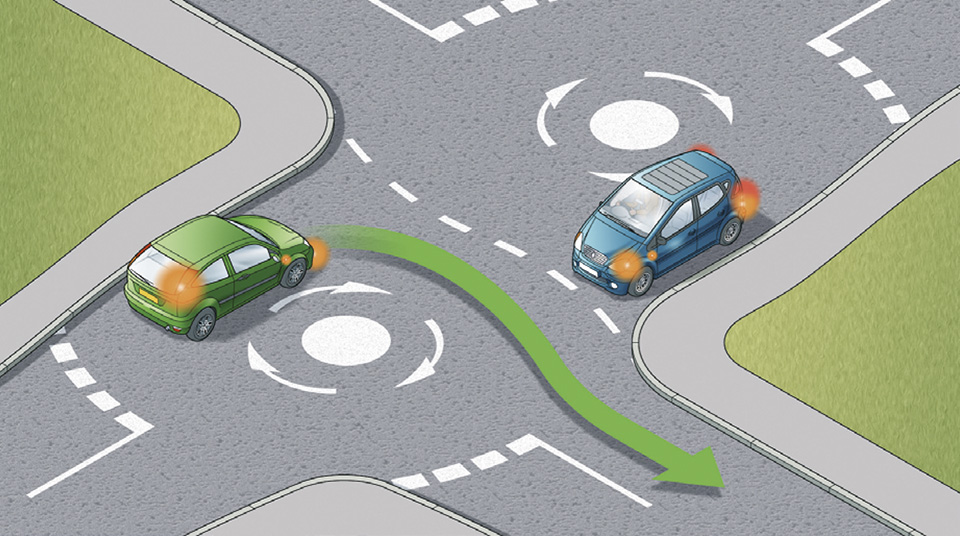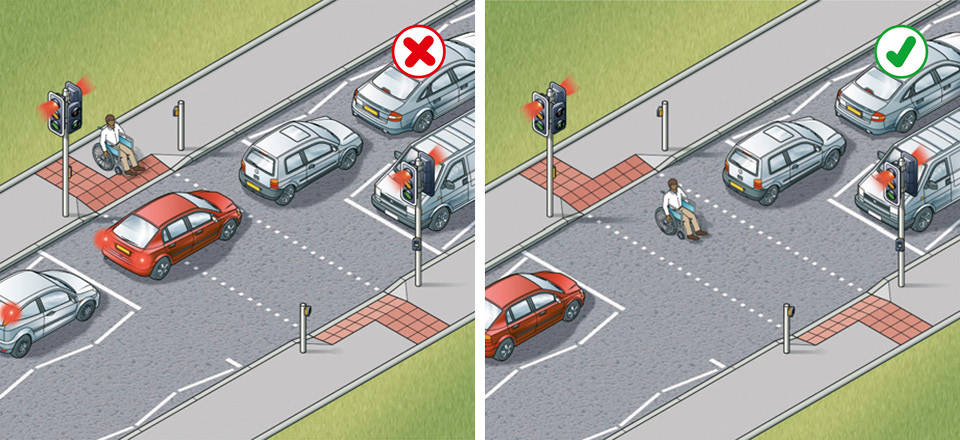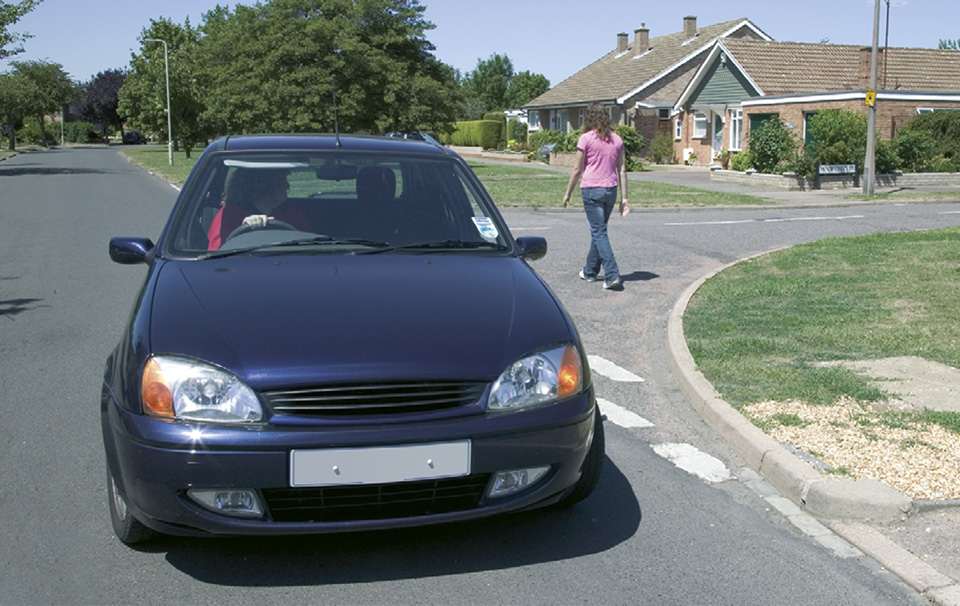Highway Code Rule 189
At double mini-roundabouts treat each roundabout separately and give way to traffic from the right.
Section: Using the road (rules 159 to 203) Subsection: Roundabouts (rules 184 to 190)Highway Code Rule 190
Multiple roundabouts. At some complex junctions, there may be a series of mini-roundabouts at each intersection. Treat each mini-roundabout separately and follow the normal rules.

Highway Code Rule 191
You MUST NOT park on a crossing or in the area covered by the zig-zag lines. You MUST NOT overtake the moving vehicle nearest the crossing or the vehicle nearest the crossing which has stopped to give way to pedestrians.
Laws
- The Zebra, Pelican and Puffin Pedestrian Crossings Regulations and General Directions 1997: Regulations 18, 20 & 24
- Road Traffic Regulation Act 1984: Section 25(5)
- The Traffic Signs Regulations and General Directions 2002: Regulations 10, 27 & 28
Highway Code Rule 192
In slow-moving and queuing traffic you should keep crossings completely clear, as blocking these makes it difficult and dangerous for pedestrians to cross. You should not enter a pedestrian crossing if you are unable to completely clear the crossing. Nor should you block advanced stop lines for cycles.

Highway Code Rule 193
You should take extra care where the view of either side of the crossing is blocked by queuing traffic or incorrectly parked vehicles. Pedestrians may be crossing between stationary vehicles.
Section: Using the road (rules 159 to 203) Subsection: Pedestrian crossings (rules 191 to 199)Highway Code Rule 194
Allow pedestrians plenty of time to cross and do not harass them by revving your engine or edging forward.
Section: Using the road (rules 159 to 203) Subsection: Pedestrian crossings (rules 191 to 199)Highway Code Rule 195
Zebra and parallel crossings. As you approach a zebra crossing
- look out for pedestrians waiting to cross and be ready to slow down or stop to let them cross
- you should give way to pedestrians waiting to cross
- you MUST give way when a pedestrian has moved onto a crossing
- allow more time for stopping on wet or icy roads
- do not wave, flash your lights or use your horn to invite pedestrians across; this could be dangerous if another vehicle is approaching
- be patient, do not sound your horn or rev your engine as this can be intimidating
- be aware of pedestrians approaching from the side of the crossing.
A zebra crossing with a central island is two separate crossings (see Rules 19 and 20).
Parallel crossings are similar to zebra crossings, but include a cycle route alongside the black and white stripes.
As you approach a parallel crossing
- look out for pedestrians or cyclists waiting to cross and slow down or stop
- you should give way to pedestrians or cyclists waiting to cross
- you MUST give way when a pedestrian or cyclist has moved onto a crossing
- allow more time for stopping on wet or icy roads
- do not wave, flash your lights or use your horn to invite pedestrians or cyclists across; this could be dangerous if another vehicle is approaching
- be patient, do not sound your horn or rev your engine as this can be intimidating
- be aware of pedestrians or cyclists approaching from the side of the crossing.
A parallel crossing with a central island is two separate crossings (see Rules 19 and 20).
Law
Section: Using the road (rules 159 to 203) Subsection: Pedestrian crossings (rules 191 to 199)Highway Code Rule 196
Pelican crossings. These are signal-controlled crossings where flashing amber follows the red ‘Stop’ light. You MUST stop when the red light shows. When the amber light is flashing, you MUST give way to any pedestrians on the crossing. If the amber light is flashing and there are no pedestrians on the crossing, you may proceed with caution.
Laws
- The Zebra, Pelican and Puffin Pedestrian Crossings Regulations and General Directions 1997: Regulations 23 & 26
- Road Traffic Regulation Act 1984: Section 25(5)

Highway Code Rule 197
Pelican crossings which go straight across the road are one crossing, even when there is a central island. You MUST wait for pedestrians who are crossing from the other side of the island.
Laws
- The Zebra, Pelican and Puffin Pedestrian Crossings Regulations and General Directions 1997: Regulations 26
- Road Traffic Regulation Act 1984: Section 25(5)
Highway Code Rule 198
Give way to anyone still crossing after the signal for vehicles has changed to green. This advice applies to all crossings.
Section: Using the road (rules 159 to 203) Subsection: Pedestrian crossings (rules 191 to 199)Highway Code Rule 199
Toucan, puffin and equestrian crossings. These are similar to pelican crossings, but there is no flashing amber phase; the light sequence for traffic at these three crossings is the same as at traffic lights. If the signal-controlled crossing is not working, proceed with extreme caution. Do not enter the crossing if you are unable to completely clear it, to avoid obstructing pedestrians, cyclists or horse riders.
Section: Using the road (rules 159 to 203) Subsection: Pedestrian crossings (rules 191 to 199)Highway Code Rule 200
Choose an appropriate place to manoeuvre. If you need to turn your vehicle around, wait until you find a safe place. Try not to reverse or turn round in a busy road; find a quiet side road or drive round a block of side streets.
Section: Using the road (rules 159 to 203) Subsection: Reversing (200 to 203)Highway Code Rule 201
Do not reverse from a side road into a main road. When using a driveway, reverse in and drive out if you can.
Section: Using the road (rules 159 to 203) Subsection: Reversing (200 to 203)Highway Code Rule 202
Look carefully before you start reversing. You should
- use all your mirrors
- check the ‘blind spot’ behind you (the part of the road you cannot see easily in the mirrors)
- check there are no pedestrians (particularly children), cyclists, other road users or obstructions in the road behind you.
Reverse slowly while
- checking all around
- looking mainly through the rear window
- being aware that the front of your vehicle will swing out as you turn.
Get someone to guide you if you cannot see clearly.

Highway Code Rule 203
You MUST NOT reverse your vehicle further than necessary.

